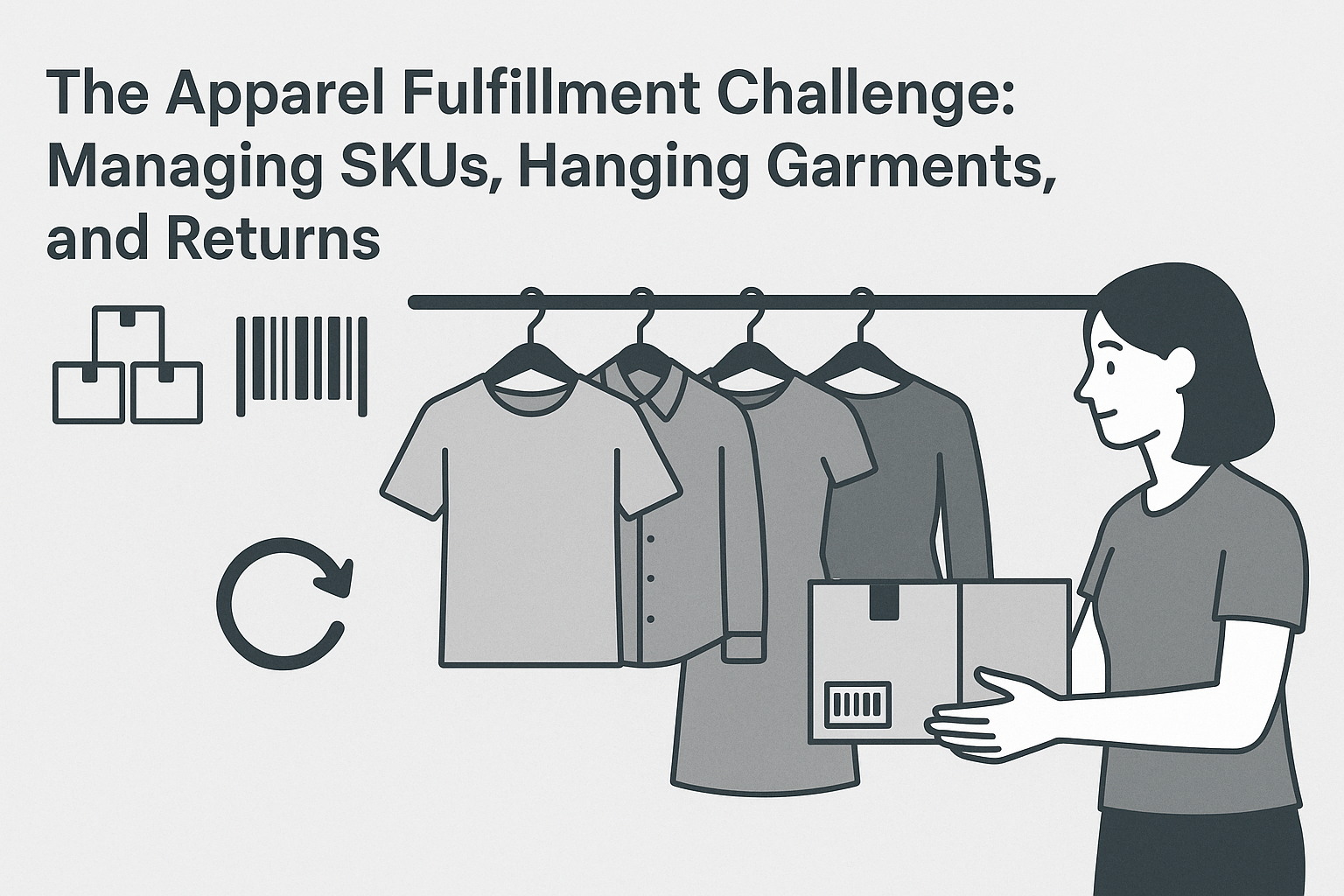In the fast-paced world of e-commerce, the fashion industry presents a unique and often complex set of logistics challenges. Unlike a simple box of electronics or a non-perishable food item, apparel comes with its own set of rules. From managing thousands of unique SKUs for different sizes and colors to handling delicate hanging garments and the high volume of returns, apparel fulfillment requires a specialized approach. Without a solid strategy, brands can quickly find themselves drowning in operational inefficiencies, leading to dissatisfied customers and a hit to their bottom line.
This guide dives deep into the specific hurdles faced by fashion and apparel brands and provides actionable insights and solutions. We’ll explore why standard fulfillment models fall short and how partnering with a specialized third-party logistics (3PL) provider like WarehouseTX can transform your supply chain, boost customer satisfaction, and drive sustainable growth. By the end, you’ll have a clear roadmap for conquering the apparel fulfillment challenge and building a resilient, scalable logistics operation.
The Triple Threat: Why Apparel Fulfillment is So Challenging
The apparel industry isn’t just about selling clothes; it’s about managing a logistical puzzle with three primary pieces that must fit together perfectly: SKU proliferation, specialized handling, and a high-volume returns process.
1. SKU Proliferation: A Management Nightmare
Imagine a single T-shirt design. It comes in three colors: red, blue, and black. For each color, you have five sizes: XS, S, M, L, and XL. Suddenly, that one product has 15 different SKUs. Now, multiply that by a catalog of hundreds or thousands of different products, and you’re dealing with an exponential increase in complexity. This SKU explosion creates significant challenges for inventory management and picking processes.
- Picking Accuracy: A customer orders a medium blue shirt. An error in the picking process sends them a large red one. This simple mistake leads to a frustrated customer, a potential negative review, and the added cost of a return.
- Storage Space: Different sizes and colors must be organized efficiently to prevent mix-ups and ensure fast picking. This often requires more shelving and a meticulously planned warehouse layout.
- Inventory Synchronization: Keeping track of stock levels across multiple e-commerce platforms (Shopify, Amazon, etc.) for every single SKU is a full-time job. A miscount can lead to overselling or lost sales.
2. Hanging Garments and Specialized Handling
Many high-end or delicate apparel items, such as dresses, suits, and formal wear, cannot be simply folded and packed. They require specialized handling to prevent wrinkles, damage, and loss of quality. This is where the concept of “hanging garment” logistics comes into play.
- Dedicated Storage: Hanging garments require dedicated rail systems or specialized racks within a climate-controlled environment to maintain their pristine condition. This is a stark contrast to the standard bin or shelf storage used for boxed goods.
- Handling and Packing Expertise: The picking process for these items is different. They must be carefully removed from the rack and packed into special boxes or garment bags to prevent wrinkling during transit. A standard fulfillment team might not have the training or infrastructure for this.
- Increased Complexity: Managing a mix of both folded and hanging garments within the same warehouse adds a layer of operational complexity that only a seasoned 3PL can handle efficiently.
3. The Returns Avalanche: A Reverse Logistics Nightmare
The fashion industry has one of the highest return rates in e-commerce, with percentages often ranging from 20% to as high as 40%. This “returns avalanche” is a massive logistical and financial burden if not managed correctly. An efficient return management system is no longer a luxury—it’s a necessity for survival.
A poorly managed returns process can lead to:
- Increased Costs: The cost of shipping, inspection, repacking, and restocking a returned item can quickly eat into profit margins.
- Delayed Restocking: If returned items are not processed quickly, valuable inventory sits in a “returns queue” instead of being available for sale. This directly impacts your bottom line.
- Poor Customer Experience: A slow or difficult return process is a major reason customers abandon a brand. An effortless return experience, on the other hand, builds brand loyalty and trust.
The Case for a Specialized 3PL: A Comparative Analysis
While an in-house fulfillment team or a generalist 3PL might seem like viable options, a closer look reveals their limitations when it comes to the specific demands of apparel.
Generalist 3PL vs. Specialized Apparel 3PL
| Feature | Generalist 3PL | Specialized Apparel 3PL |
|---|---|---|
| SKU Management | Basic barcode scanning; prone to errors with high SKU counts. | Advanced WMS (Warehouse Management System) designed for high SKU volume; sophisticated slotting and picking algorithms. |
| Handling & Storage | Primarily uses standard bins and shelving; limited or no capacity for hanging garments. | Dedicated hanging garment storage, climate-controlled facilities, and specialized packing stations. |
| Return Management | Often treats returns as an afterthought; slow inspection process; high risk of inventory lag. | Dedicated reverse logistics team; fast inspection (quality control); same-day restocking; clear return policy integration. |
| Value-Added Services | Limited to basic kitting or labeling. | Expertise in custom packaging, polybagging, kitting, and gift wrapping, all crucial for apparel brands. |
| Scalability | Can handle volume increases but may struggle with the complexity of apparel’s unique demands. | Built to scale with seasonal peaks and brand growth without sacrificing accuracy or speed. |
Case Study: The Rise of a Boutique Brand
A growing online boutique, “Luxe Threads,” initially handled its fulfillment in-house. They focused on high-quality, delicate dresses and suits. As their brand grew, they faced a critical bottleneck:
- Their small warehouse was a mess of tangled hangers and mismatched sizes.
- Returns were piling up, and it took days to process them, leading to angry customer emails.
- Their team was spending more time on logistics than on marketing and design.
Luxe Threads partnered with a specialized 3PL that understood the nuances of apparel. The 3PL implemented a system with dedicated hanging garment racks, a streamlined returns process with same-day restocking, and advanced WMS software. Within six months, Luxe Threads saw a 25% reduction in fulfillment costs, a 90% reduction in return processing time, and a significant boost in positive customer reviews. This partnership allowed the brand to focus on what they do best: creating beautiful clothes.
Essential Features to Look for in an Apparel 3PL Partner
Choosing the right logistics partner is the most critical decision a growing apparel brand can make. Here’s a checklist of non-negotiable features to look for:
1. Advanced Warehouse Management System (WMS)
A state-of-the-art WMS is the brain of your fulfillment operation. For apparel, this means a system that can accurately track every single SKU, from a size XS blue shirt to a size L black one. It should offer real-time inventory visibility and integrate seamlessly with your e-commerce platforms like Shopify, Magento, or BigCommerce.
2. Expertise in Value-Added Services
Apparel fulfillment is more than just picking and packing. Look for a 3PL that offers:
- Kitting & Assembly: For subscription boxes or curated outfits.
- Polybagging & Repackaging: Essential for protecting garments and presenting them professionally.
- Branded Packaging: A crucial part of the customer unboxing experience.
- Quality Control (QC): A final inspection before shipping to prevent errors.
3. A Robust Reverse Logistics Solution
This is where a specialized partner truly shines. A dedicated return management process should include:
- Fast receiving and inspection of returned items.
- Immediate restocking of sellable items.
- Efficient disposal or donation of unsellable goods.
- Clear communication with the customer throughout the process.
A streamlined return process not only reduces costs but also turns a potential negative experience into a positive one, encouraging repeat business.
Future-Proofing Your Brand: The Role of a Strategic 3PL
As the e-commerce landscape evolves, so do customer expectations. Consumers expect fast, free, and accurate shipping, and a hassle-free return process. By partnering with a specialized apparel 3PL, you’re not just outsourcing a task; you’re building a strategic partnership that future-proofs your brand.
A well-chosen partner like WarehouseTX, with its nationwide network of fulfillment centers in key locations like Texas, New Jersey, and California, can help you achieve:
- Reduced Shipping Costs: By placing inventory closer to your customers.
- Faster Delivery Times: Enabling 2-day or even next-day shipping.
- Improved Customer Loyalty: Through a superior post-purchase experience.
In the competitive world of fashion e-commerce, logistics is no longer just a cost center—it’s a key differentiator. The brands that master the apparel fulfillment challenge are the ones that will win the market.
Frequently Asked Questions (FAQ)
What is an apparel fulfillment center?
An apparel fulfillment center is a specialized warehouse designed to handle the unique needs of the fashion industry. This includes managing a high volume of SKUs (for different colors, sizes, and styles), handling delicate or hanging garments, and processing a large number of returns efficiently. These centers use advanced technology and processes tailored to clothing logistics, unlike a generalist warehouse that handles all types of products.
Why are returns so high in the apparel industry?
Apparel has a high return rate primarily because of fit and feel. Customers can’t try on items before they buy them, leading to frequent returns due to incorrect sizing, unexpected fabric quality, or simply not liking the item once it arrives. A streamlined return process is crucial for managing these returns efficiently and maintaining customer satisfaction.
How can a 3PL help with managing SKUs?
A specialized 3PL uses a sophisticated Warehouse Management System (WMS) to track every individual SKU accurately. Their systems are built to handle the sheer volume of apparel variants, minimizing picking errors and ensuring that the right product is sent to the right customer every time. This automation and expertise free up brands from the tedious task of manual inventory tracking.
What is the difference between hanging garment logistics and standard warehousing?
Standard warehousing typically involves storing items in boxes or bins on shelves. Hanging garment logistics, on the other hand, involves using specialized racks and rail systems to store apparel on hangers. This prevents wrinkles and damage, preserving the quality of the clothing, especially for high-end items like dresses, suits, and formal wear. It requires a different infrastructure and handling protocol.
How can I improve my brand’s return process?
To improve your return process, consider partnering with a 3PL that offers a robust reverse logistics solution. This includes providing customers with easy-to-use return labels, ensuring quick and accurate inspection of returned items, and processing refunds or exchanges promptly. A fast, hassle-free return experience can turn a returning customer into a loyal advocate for your brand.

